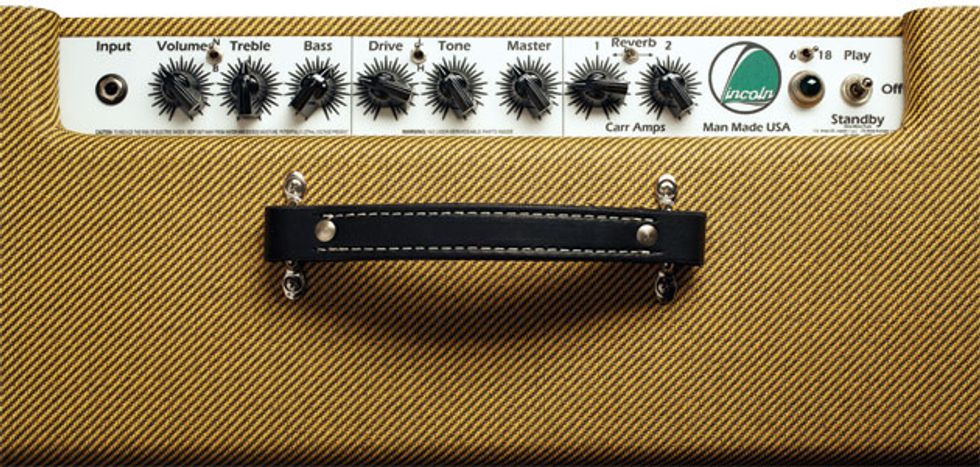Writing about Vox-style amps can be tough! So many of the words that describe their iconic tones can sound like putdowns: “The distortion crackles and fizzes, but in a good way.” “The cabinet and speaker have a boxy midrange resonance, but it’s a cool kind of boxy.” Guitar writers inevitably whip out the word “chime,” but, really, do AC30s and AC15s sound anything like a struck bell? Chimes aren’t known for slashing upper-midrange breakup—a signature quality of Vox distortion. But while adjectives and verbs often fail to capture the glory of those EL84 tones, amp builder Steve Carr’s latest release nails it.
Carr’s Lincoln combo doesn’t clone any particular Vox model—it’s more of a freewheeling fantasia on “Voxiness” in general, one that departs from tradition as often as it adheres to it. Both its channels employ a pair of EL84 power tubes à la Vox’s AC15 and, yes, the Lincoln does a fine AC15 impersonation. But that’s only one of the amp’s cast of characters. Many unconventional details expand the Lincoln’s range without relinquishing its mid-’60s vibe. It’s a savvy compromise between tradition and innovation.
New Tones in Two-Tone
The Lincoln is a looker. Our review model boasts showy two-tone Tolex, an asymmetric speaker cutout in the form of a sideways shield, and, in a nod to Vox styling, gold-thread piping. The solid-pine cabinetry is masterful.
The amp’s guts are equally striking, if less photogenic. There’s no turret board—this is mostly point-to-point wiring (though a few subsections are assembled on small circuit boards). Frankly, it looks like a rat’s nest decorated with glue-gun blobs. (Steve Carr says newer production versions are much tidier.) But a few pokes with a (nonconductive!) wooden chopstick confirm that the components are perfectly secure. This is a complex circuit with many parts—and a seriously labor-intensive build. Factor in the high-end parts (including Solens capacitors from the aerospace industry and custom-spec TMI transformers) and superior hardware, and it’s no shock that Lincoln costs close to three grand.
Each preamp section uses a pair of 12AX7 preamp tubes. The rectifiers are solid-state. There’s a stompbox-sized footswitch (included) for channel switching and adding a subtle but effective overdrive boost. You can set reverb levels independently for each channel.
Clean to Mean
Channel 1’s volume control is beautifully tapered. You get squeaky-clean tones only in the lowest quadrant. Above that, overdrive accumulates smoothly and steadily. The channel feels like it wants to ignite into overdrive, but don’t fear for the clarity of your clean-toned parts; even the hottest settings retain crisp definition and harmonic clarity. You can nudge tones toward the dirty side without muddiness or flatlined compression.

The bright/normal switch can lend a glassy edge reminiscent of Vox’s Top Boost combos. (“Glassy” is another word that can sound negative, but isn’t in this case.) It’s great for those sizzling mid-period Beatles riffs. Or just toggle to normal and advance the gain for superb early-Zep colors.
The tone circuit is deceptively simple. There are only two knobs—treble and bass—yet Lincoln provides more midrange control than many amps with a dedicated mid knob. As you advance the treble, low mids are siphoned away—clarifying tones and making highs glisten. Maximum treble settings are super-bright, but never nasty. Meanwhile, the virile bass control regulates lows and low mids. (It’s great for bulking up single-coil pickups. I’ve never heard lipstick tubes sound so beefy!) It interacts with the treble control’s mid scoop, providing a smorgasbord of midrange flavors. The tone controls sound great no matter how they’re set, and all settings clean up beautifully when you back off your guitar’s volume.
The spring reverb has a bright, splashy California feel. Clean tones and maxed-out reverb yield epic surf tones—something you might not expect from a Vox-inspired amp.
Drive All Night
The channel 2 controls are drive, tone, and master, with a high/low toggle duplicating the footswitch boost function. Despite the high gain profile, channel 2 maintains a Voxy character—or at least Vox by way of Marshall 18-watt. It certainly goes places vintage Voxes don’t, offering creamy compression and muscular chunk. It’s easy to imagine Marshall-loving hard rockers hanging out here.
Ratings
Pros:
Stunning Vox-inspired tones. Superb build. Innovative departures from the vintage template. Drop-dead looks.
Cons:
Oh, my aching wallet!
Tones:
Ease of Use:
Build/Design:
Value:
Street:
$2,830 ($2,980 as reviewed with two-tone color scheme)
Carr Lincoln
carramps.com
As on the clean channel, tones maintain crackling clarity, even at hot settings. Notes can sing with endless sustain in Brain May fashion, even without adding a resonant booster pedal like May uses. Lowering your guitar volume generates cool tone variations, though the hot channel never cleans up like channel 1 does. Lower-gain tones are a bit on the dark side—not a bad thing, since that quality prevents shrillness at super-hot settings. The Lincoln never shrieks.
The single-knob tone control is a stroke of genius. It’s not a simple treble trim, as on most single-tone-knob amps, but more of a midrange sculpting tool. It’s great for highlighting the character of a particular pickup. Humbuckers, P-90s, lipstick tubes, Filter’Trons, and Fender single-coils all yield stellar tones. The channel simply doesn’t need bass or treble controls.
Quiet Storm
The Lincoln sounds magnificent at its full 18 watts, but it’s no less splendid at six watts—just quieter. It’s easy to summon huge tones, eternal sustain, and controlled feedback at lower power. When listening back to recorded performances, I find it hard to believe it’s not a larger, louder amp. It’s a potent six watts, though—perhaps even a bit loud for home use.
The 12", 65-watt Celestion Creamback is a fine speaker choice. It sounds a lot like the Celestion Greenbacks that appeared in many vintage Voxes, but with more power. That extra headroom benefits Lincoln’s hotter-than-vintage sounds and plays nice with gain pedals that might overload a lower-wattage traditional speaker such as Celestion’s 15-watt Alnico Blue.
The Verdict
Carr’s Lincoln expands on—and sometimes improves—the sounds of classic Vox combos. At all settings it’s an uncommonly euphonious amp. Close intervals ring harmoniously. Complex chords remain clear and balanced. Set the damn knobs any which way—Lincoln still sings sweetly. The price? Ouch. But the amp’s versatility, stunning tones, fine craftsmanship, labor-intensive build techniques, and many clever innovations make the stiff sum easier to swallow.
Watch the Review Demo:









![Rig Rundown: Russian Circles’ Mike Sullivan [2025]](https://www.premierguitar.com/media-library/youtube.jpg?id=62303631&width=1245&height=700&quality=70&coordinates=0%2C0%2C0%2C0)

















